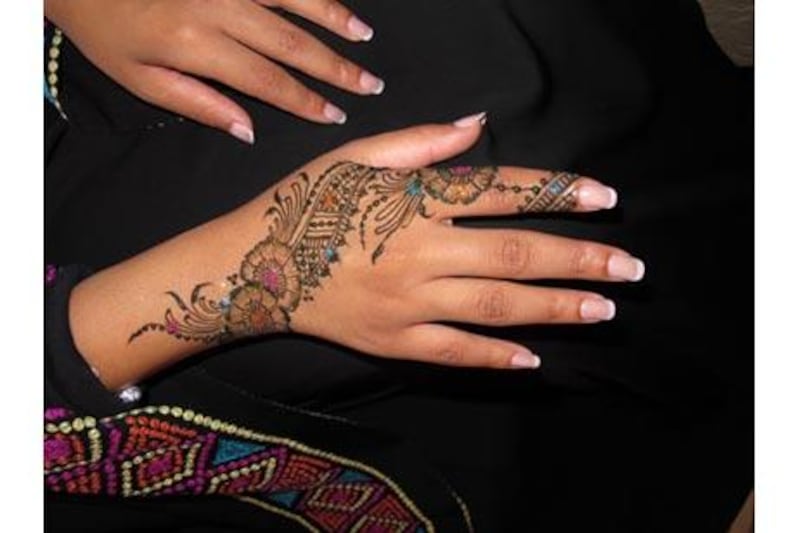Reports linking synthetic forms of henna to higher rates of leukaemia in women will have been cause for alarm in the UAE, where the use of the dye goes - almost literally - hand in hand with celebration. Derived from the henna plant, the traditionally dark red dye is applied in elaborate patterns to women's hands, feet and hair during Eid as well as weddings, engagements and birthdays. Tourists also flock to henna parlours to adorn themselves in a slice of Middle Eastern culture.
The study by UAE University in Al Ain found that the rates of acute myeloid leukaemia (AML) and acute lymphoblastic leukaemia (ALL), both often-fatal cancers of the blood and bone marrow, and which are usually more common in men, were significantly higher in Emirati women. The figures, published in the journal Leukaemia and Lymphoma, showed AML to be 93 per cent more common in Emirati women than men, with a similar difference in the frequency of ALL cases. The increased rate of occurrence could, according to Dr Inaam Hassan, an associate professor at the UAE University, be linked to the use of chemicals in synthetic henna dye.
"I could not understand the results," she said at the time, "because men and women live in the same environment, they eat the same foods and breathe the same air. The only difference was the use of henna." Crucially, though, it is not the natural form of henna - powdered from the plant and mixed with water - that is of concern. Instead, it is the increasingly popular synthetic versions of the dye, which have been mixed with other substances and in some cases contain no natural henna at all, that warrant further investigation.
Of the added ingredients, the oil/coal derivative benzene is the most worrying. Banned as a solvent in the US and in consumer products in Europe because of its carcinogenic properties, elsewhere it is often mixed with henna to deepen the dye's colour. "In the past," says Dr Hassan Galadari, an assistant professor at the UAE University and a practising dermatologist, "henna was just pure henna. But recently, when some health spas starting boasting longer-lasting henna that was darker in colour, for them to achieve that, they need to mix it with other stuff. One of the things they mix it with is benzene."
Benzene is routinely used in products such as plastic and rubber, but because henna is usually left on the skin for at least a few hours, exposure to any used in cosmetics is very high. One factor that has led to the increasing use of synthetic henna is a preference for so-called "black henna", whose colour deepens more quickly and stays on the skin for longer, sometimes for up to three weeks (natural henna only lasts for a week to 10 days).
To achieve the colour, it is mixed with chemical dyes, some of which can cause sensitivity or an allergic reaction when applied to the skin. Here, benzene is not the main suspect. "Most of the time," says Galadari, "this is not caused by the benzene but by the paraphenylenediamine (PPD)" - a chemical used in most hair dyes, but not approved as a skin colourant. Apart from the skin reaction, PPD itself is not dangerous, he says (although some studies have linked it to cancer). More so is a second chemical, the benzene derivative pyrogallol, which is also frequently added to black henna.
Unlike PPD, benzene and its derivatives have no discernible effect on the skin, which makes them hard to detect. "You have to trust the salon," says Sara al Aslai, a corporate meeting and incentives executive at the Abu Dhabi Tourism Authority, who gets her henna done at Qamar or Rachna salons in Dubai. "If it starts burning when they apply it then you know it contains chemicals. We have a lady who comes to our house. We trust her because we know she does the good henna, not the bad one." Most women, she says, are aware of the difference.
Strangely, knowing the risks does not stop women from asking for black henna. "If they see somebody with black henna, they want the same," says Rachna Thakker, the owner of Dubai's Rachna salon chain. "We only use natural henna with oil. We had to do black henna for a while because all the other salons were doing it, but we stopped two years ago because it caused some allergies. Many women who come to us ask why we don't do it when many other salons do."
Khursheed Husain, owner of the Henna Beauty Parlour in Bur Dubai, does offer black henna if people ask for it. "If they want it I can add a bit of dye, but for kids it's not advisable," she says. The salon also offers natural henna with oil. "When it comes to health," says Galadari, "bad things never deter you from doing it. It's like smoking, or sunbathing. They don't care, as long as it makes them look good. They're just looking for a short-term benefit."
It is, says Khaleefa al Romaithi, head of public health at Abu Dhabi Municipality, which is in the process of implementing stringent checks on the city's salons, a case of demand and supply. "The salons provide black henna because the customers ask for it and they are trying to make customers happy." Over the past three months, municipal inspectors have been working their way through the city's 4,000 salons and sending samples off to the Health Authority for testing. "Eighty per cent of the salons we have seen are using only natural henna," he says. Fines of up to Dh10,000 and a court summons are issued to salons found to be doing otherwise.
Both PPD and pyrogallol have been detected in samples sent in by the municipality, says Dr Mohammed Abu Elkhair, head of the drug and medical products regulation section at the Health Authority, who is leading the tests. Unfortunately, it is not as simple as "red henna good, black henna bad", as synthetic darkening chemicals such as benzene can also be added to the "natural-looking" red henna. Until the practice of synthetic henna is stamped out, says Galadari, the only way of being 100 per cent sure of what is in the henna is by mixing it yourself at home.
Al Romaithi offers a rather more practical solution. "We now always advise the salons to only mix the henna in front of the customer, so they can see what's in it," he says. "The customer should ensure that they do this." There is, though, a limit to the powers of the authorities. "We can control what happens in the salons, but we cannot control what happens at home. Many ladies want to look beautiful without caring about the dangers to their body," says al Romaithi. The municipality is planning to launch an awareness campaign later in the year to teach women what can safely be added to henna and what is risky. "No dyes, paint or chemicals," he says.
In the meantime, says Abu Elkhair, women are encouraged to report any salon offering henna that looks or feels suspicious to the municipality. "With our collaboration, we can go and find out more about what compounds these salons are using, where they are getting them from and how. Then we can mitigate the risk."






